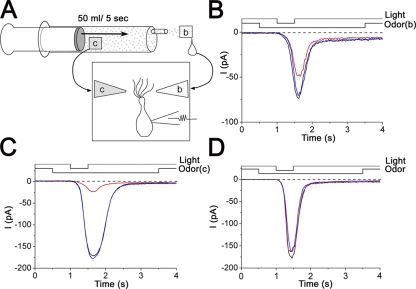Figure 3.
Blockage of cAMP-induced current by vapor-exposed Ringer's solution. (A) Procedure of the vapor exposure of Ringer's solution and its application to the cell under the recording. Odorant-containing solution (0.1%, 40 µl) was put to a filter paper (c) and was inserted in the 50-ml syringe to evaporate the odorant molecules for 15 min. The vapor was gently applied with a rate of 50 ml/5 s onto the filter paper wet by 40 µl of normal Ringer's solution (b). After the vapor-exposed solution was extracted, it was put into the puffer pipette. (B) Effect of vapor-exposed Ringer's on the cAMP-induced current. Odorant put into the syringe was 0.1% dihydromyrcenol. Vh = −50 mV. The light-induced current was recorded as a control (black). Next, light-induced current response was obtained in the presence of the vapor-exposed Ringer's stimulation (red). After a 20-s interval, current recovery (blue) was confirmed. Pressure of odorant stimulation was 50 kPa. Light intensity was 0.28. Downward deflection of the upper traces indicates the timing and duration of the light and odor stimulation. Vh = −50 mV. (C) Current suppression by a direct puff-application of 0.1% dihydromyrcenol. Vh = −50 mV. Different cell from B. (D) The same experiments as B, except that limonene 0.1% was used for the odorant. Vh = −50 mV.

